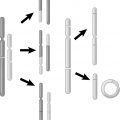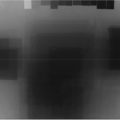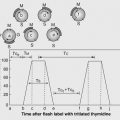17
RADIATION CARCINOGENESIS
BINDU V. MANYAM AND MICHAEL A. WELLER
Question 1
What is the threshold dose?
Question 3
What is a stochastic effect?
Question 1 What is the threshold dose?
Answer 1
Ionizing radiation leads to DNA damage which, if not adequately repaired, can prevent a cell from surviving or can lead to a mutation, which is retained through subsequent divisions. The organs and tissues in the body can continue to function in the event of a loss of a few cells; however, if there is a substantial loss of cells, there can be loss of organ or tissue function. At small radiation doses, the probability of this occurring is zero. However, the threshold dose is the dose at which the probability of observable harm and loss of tissue function approaches 100%.
Hall EJ, Giaccia AJ. Radiation carcinogenesis. In: Hall EJ, Giaccia AJ, eds. Radiobiology for the Radiologist. 7th ed. Philadelphia, PA: Lippincott Williams & Wilkins; 2012:135–153.
Question 3 What is a stochastic effect?
Answer 3
Stochastic effects have no threshold dose—harmful effects can occur at any dose and the severity of harm is independent of dose. Similar to deterministic effects, the probability of harm increases with dose. Carcinogenesis is an example of a stochastic effect. A radiation dose of 1 Gy and a radiation dose of 10 Gy can both induce carcinogenesis with no difference in the severity of cancer, but a dose of 10 Gy has a higher probability of inducing carcinogenesis.
Hall EJ, Giaccia AJ. Radiation carcinogenesis. In: Hall EJ, Giaccia AJ, eds. Radiobiology for the Radiologist. 7th ed. Philadelphia, PA: Lippincott Williams & Wilkins; 2012:135–153.
Question 5
Can cancers induced by radiation be distinguished from those cancers not associated with radiation exposure?
Question 7
What models are used to assess the risk of cancer from radiation exposure?
Question 5 Can cancers induced by radiation be distinguished from those cancers not associated with radiation exposure?
Answer 5
No molecular markers have been identified to date, which can distinguish radiation-induced cancers from those not associated with radiation. Cahan et al. proposed three criteria in 1948 for a malignancy to be considered radiation induced: the neoplasm must arise within a previously irradiated field, a latent period of several years (>5 years) must exist between radiation therapy (RT) and development of malignancy, and the second malignancy must be histologically distinct from the first tumor.
Cahan WG, Woodard HQ, Higinbotham NL, Stewart FW, Coley BL. Sarcoma arising in irradiated bone: report of eleven cases. Cancer. 1998;82:8–34.
Hall EJ, Giaccia AJ. Radiation carcinogenesis. In: Hall EJ, Giaccia AJ, eds. Radiobiology for the Radiologist. 7th ed. Philadelphia, PA: Lippincott Williams & Wilkins; 2006:135–153.
Question 7 What models are used to assess the risk of cancer from radiation exposure?
Answer 7
The absolute risk model, the relative risk model, and the time-dependent relative risk models are used to assess the risk of cancer from radiation exposure. The absolute risk model theorizes that the excess risk of cancer due to radiation exposure is not dependent on the baseline risk of cancer when there is no radiation exposure. On the other hand, the relative risk model theorizes that the excess risk of cancer due to radiation exposure is dependent on the baseline risk of cancer. For example, the natural incidence of cancer increases significantly with age, and the relative risk model predicts that the excess risk is also increased with age. The time-dependent relative risk model is preferred by the Biological Effects of Ionizing Radiation (BEIR) committee. It predicts that the excess risk of cancer is dependent on a number of variables, including dose, the square of the dose, age at exposure, and time since exposure.
Little MP, Muirhead CR, Charles MW. Describing time and age variations in the risk of radiation-induced solid tumour incidence in the Japanese atomic bomb survivors using generalized relative and absolute risk models. Stat Med. 1999;15:17–33.
Question 8
How does the risk of radiation-induced cancer differ with age of exposure?
Question 10
What organ has the highest sensitivity for radiation carcinogenesis in children?
Question 8 How does the risk of radiation-induced cancer differ with age of exposure?
Answer 8
The risk of radiation-induced cancer decreases with increasing age at the time of exposure. Individuals exposed to radiation as adults demonstrate a decreasing dose–response relationship. There is a clear dose–response relationship for individuals who were exposed as children. Excessive relative risk (ERR) per Seivert was shown to be 9.5 for children exposed under the age of 10 years old, and 3.0 for individuals exposed at ages 10 to 19 years old. This phenomenon is likely secondary to the increased number of years of life to develop a malignancy, as well as a larger proportion of actively dividing cells in the radiosensitive phase of the cell cycle.
Hall EJ, Giaccia AJ. Radiation carcinogenesis. In: Hall EJ, Giaccia AJ, eds. Radiobiology for the Radiologist. 7th ed. Philadelphia, PA: Lippincott Williams & Wilkins; 2012:135–153.
Thompson DE, Mabuchi K, Ron E, et al. Cancer incidence in atomic bomb survivors. Part II: Solid tumors, 1958–1987. Radiat Res. 1994;137:17–67.
Stay updated, free articles. Join our Telegram channel

Full access? Get Clinical Tree






